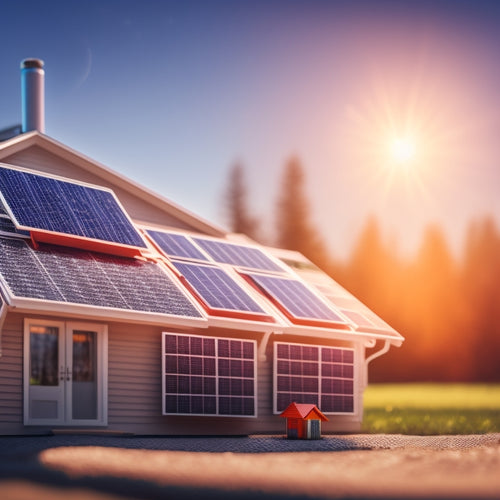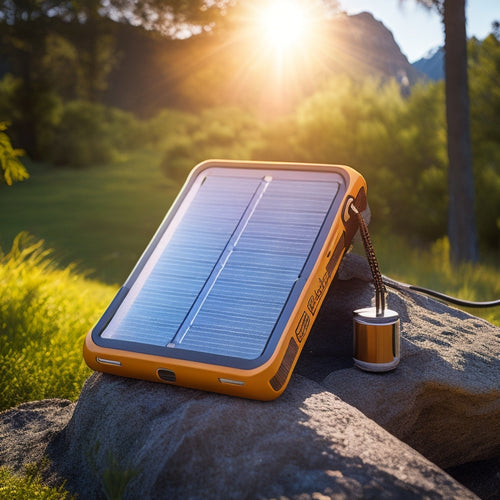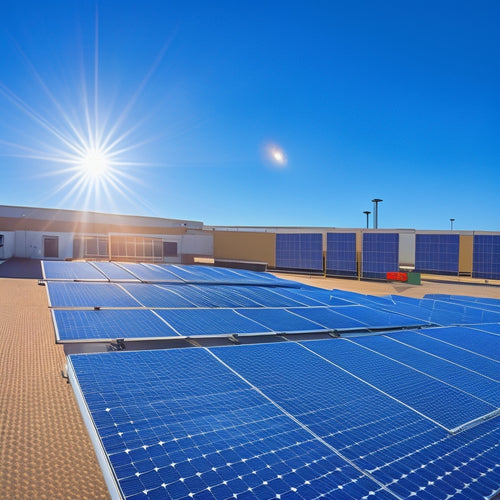
Most Efficient Photovoltaic Cells
Share
If you're looking for the most efficient photovoltaic cells, consider options that employ advanced materials like perovskites and multi-junction designs. These technologies can achieve energy conversion rates exceeding 25%. Bifacial modules also enhance performance by capturing sunlight from both sides, greatly increasing output. Durability under extreme conditions guarantees longevity, while innovative coatings optimize light absorption. As you assess your energy needs, remember that these efficient cells not only reduce utility costs but also promise long-term savings. Exploring these advancements reveals how they can shape your solar energy solutions effectively.
At a Glance
- Advanced material technologies, like perovskite and tandem solar cells, enhance energy conversion rates significantly compared to traditional designs.
- Innovative cell designs, such as bifacial and multi-junction configurations, maximize sunlight capture for higher overall efficiency.
- Sustainable materials and eco-friendly processes are critical for developing photovoltaic cells with reduced environmental impact.
- Investment in efficient photovoltaic systems offers long-term savings on energy bills and contributes to decreased greenhouse gas emissions.
- Durability and weather resistance of modern photovoltaic cells ensure a longer lifespan, reducing maintenance costs and replacement frequency.
Higher Energy Conversion Rates
To achieve higher energy conversion rates in photovoltaic cells, you need to take into account advanced material technologies that enhance light absorption and reduce energy losses.
Techniques such as using sustainable materials in energy conversion systems can greatly improve efficiency rates sustainable materials in energy systems.
Innovative cell designs, such as bifacial and multi-junction configurations, also play a critical role in maximizing efficiency.
Together, these developments extend the limits of solar energy utilization, ensuring ideal performance in various conditions.
Advanced Material Technologies
Advanced material technologies are revolutionizing the efficiency of photovoltaic cells by enabling higher energy conversion rates.
You'll find that innovations such as nanostructured coatings are vital in enhancing light absorption and minimizing energy losses. These coatings function at the microscopic level, optimizing the interaction between sunlight and the photovoltaic material, which ultimately leads to improved performance.
In addition, organic photovoltaics represent a significant advancement in material technology. They employ organic compounds that can be customized for specific light absorption characteristics, offering flexibility and lightweight solutions.
By integrating organic materials with nanostructured coatings, you can achieve a collaboration that enhances conversion efficiency even further.
Moreover, these advanced materials allow for the creation of tandem solar cells, where multiple layers capture different wavelengths of light. This multi-junction approach can dramatically increase the overall energy conversion rates, pushing the boundaries of what's possible in solar technology.
As you investigate these advanced technologies, you'll appreciate how they enable the pursuit of energy independence, creating a future where solar power can be exploited more effectively, allowing you to take control of your energy needs.
Innovative Cell Designs
Innovative cell designs are pushing the boundaries of energy conversion rates in photovoltaic technology. By embracing novel manufacturing techniques, these designs optimize light absorption and minimize energy loss.
For instance, bifacial solar cells capture sunlight from both sides, considerably enhancing overall efficiency. This approach not only employs available space but also capitalizes on reflected light from surrounding surfaces.
Moreover, the integration of multi-junction cells allows for the collection of a broader range of light. Each layer is customized to absorb specific wavelengths, resulting in higher energy output.
As you consider these advancements, design sustainability plays a vital role. Manufacturers are focusing on materials that reduce environmental impact while maintaining performance. The use of recycled components and eco-friendly processes guarantees that the push for efficiency doesn't compromise the planet's health.
In this realm of innovation, it's important that you stay informed and engaged. Understanding these state-of-the-art designs enables you to make choices that align with your values of freedom and sustainability.
As you investigate the world of photovoltaic cells, remember that each advancement brings us closer to utilizing energy in more efficient, responsible ways.
Cost Savings Over Time
When you invest in photovoltaic cells, you're not just paying for energy today; you're securing long-term savings on your energy bills.
The potential to reduce utility costs by 50% to 100% is a persuasive reason to reflect on this investment, especially when factoring in government incentives that can mitigate initial financial burdens.
Over time, the reduction in maintenance costs and increased energy efficiency can greatly enhance your return on investment.
Understanding these financial benefits is vital for evaluating the overall value of solar technology.
Long-Term Energy Savings
Over time, investing in photovoltaic cells can lead to considerable long-term energy savings. By utilizing solar energy, you greatly reduce your reliance on traditional energy sources, enhancing your energy independence. This shift not only decreases your monthly utility bills but also shields you from volatile energy prices, providing financial predictability.
The environmental impact of using photovoltaic cells is another critical consideration. As you generate your own electricity, you contribute to a reduction in greenhouse gas emissions, aligning your energy consumption with sustainable practices. Over the lifespan of the panels, often exceeding 25 years, the cumulative savings can be extraordinary, potentially offsetting installation costs several times over.
Moreover, as technology advances, the efficiency of photovoltaic cells continues to improve, meaning the energy savings you realize today will likely increase in the future. The initial investment in these systems can yield returns that compound over time, providing not just immediate financial relief but also long-term budget stability.
Maintenance Cost Reduction
As you consider the financial benefits of photovoltaic cells, it's important to recognize the substantial reduction in maintenance costs associated with these systems.
Efficient installation techniques play an essential role in minimizing future expenses. When installed correctly, these systems can reduce wear and tear, leading to fewer repairs and replacements over time.
Moreover, advanced monitoring systems enhance your ability to track performance and identify issues early. With real-time data, you can promptly address any inefficiencies, preventing costly downtimes and ensuring peak energy production.
This proactive approach not only saves money but also extends the lifespan of your photovoltaic cells.
Additionally, many modern photovoltaic systems are designed with durability in mind, meaning they require less frequent maintenance compared to older models.
Innovative Material Technologies
Innovative material technologies, like perovskite solar cells, are reshaping the efficiency environment of photovoltaic systems.
These advancements in materials are essential for maximizing energy storage and efficiency, particularly when paired with high-capacity deep cycle batteries for off-grid systems.
You'll find that these materials not only promise higher efficiency rates but also lower production costs compared to traditional silicon cells.
Additionally, bifacial modules are enhancing energy capture by utilizing sunlight from both sides, which could greatly enhance overall system performance.
Perovskite Solar Cells
Perovskite solar cells represent a significant advancement in photovoltaic technology, offering extraordinary efficiency and cost-effectiveness compared to traditional silicon-based solar cells. These cells employ unique perovskite materials, which have demonstrated impressive power conversion efficiencies exceeding 25%. However, you must consider some challenges, such as perovskite stability and toxicity concerns.
While the current fabrication techniques are relatively simple and low-cost, scalability challenges remain a barrier to widespread market adoption. The environmental impact of these materials also warrants attention, as certain compositions may pose risks. Despite these issues, ongoing research is focused on enhancing commercial viability.
Here's a quick overview of key aspects of perovskite solar cells:
| Aspect | Description | Challenges |
|---|---|---|
| Perovskite Stability | Varies with composition; stability is critical | Degradation over time |
| Scalability Challenges | Production methods need optimization | Large-scale manufacturing |
| Environmental Impact | Potential risks associated with certain materials | Regulatory scrutiny |
| Fabrication Techniques | Simple, low-cost methods are progressing | Consistency in quality |
| Market Adoption | Rapidly growing interest, but still emerging | Competition with silicon |
Bifacial Module Efficiency
Bifacial solar modules are gaining attention due to their ability to capture sunlight from both sides, greatly enhancing energy yield compared to traditional monofacial designs.
One of the key bifacial advantages lies in their potential to increase power generation by utilizing reflected light, especially in environments with high albedo, such as snowy or sandy areas. When considering installation, you'll need to account for the angle and height of the modules to maximize their exposure to both direct and indirect sunlight.
In terms of performance metrics, bifacial modules often exceed efficiency benchmarks set by their monofacial counterparts, leading to favorable technology comparisons.
Market trends indicate a growing adoption of this technology, driven by design innovations that optimize durability and aesthetics. These modules also present various application scenarios, from residential rooftops to large-scale solar farms.
However, it's essential to evaluate the environmental impact of these installations, ensuring that their benefits in energy yield align with sustainable practices.
As you investigate bifacial technology, understanding these factors will enable you to make informed decisions that utilize its full potential while embracing the freedom of renewable energy solutions.
Assess Your Energy Goals
To effectively assess your energy goals, start by defining your current energy requirements based on your consumption patterns.
Conducting a thorough energy audit will help you analyze usage patterns and identify inefficiencies.
Next, consider potential future expansion, as this will influence your photovoltaic system's capacity.
Balancing these factors guarantees your solar solution meets both present and anticipated needs.
Define Energy Requirements
Evaluating your energy goals is essential for determining the appropriate specifications for photovoltaic cells in your system.
Begin by analyzing your current energy consumption patterns. Track how much energy you use daily and identify peak usage times. This data is critical for establishing a baseline and understanding your energy needs.
Next, set clear efficiency metrics for your photovoltaic cells. Efficiency metrics gauge how effectively solar cells convert sunlight into usable electricity. By defining these metrics, you can compare different cell technologies and determine which best aligns with your energy goals.
Consider factors such as the average sunlight hours in your location and the orientation of your installation site, as these influence overall performance.
Once you've calculated your energy needs and set efficiency benchmarks, you can better determine the quantity and type of photovoltaic cells required.
This precision guarantees that your system not only meets your needs but also operates efficiently, maximizing both energy independence and cost savings.
Ultimately, aligning your energy consumption with the right technology enables you to achieve greater freedom in managing your energy resources.
Consider Future Expansion
When evaluating your energy goals, it's important to think about potential future expansion of your energy needs. This foresight guarantees your photovoltaic system remains aligned with your lifestyle or business growth.
Assess the scalability potential of your chosen solar technology. Can your setup easily accommodate additional panels or storage solutions as your energy demands increase?
Monitoring market trends is essential, too. As advancements in photovoltaic technology continue, new options may emerge that offer higher efficiency or lower costs. Staying informed allows you to adapt your system without considerable retrofitting, guaranteeing you maximize your investment.
Consider your long-term energy vision. Are you planning to add electric vehicles, expand operations, or enhance home automation? Each of these factors can greatly affect your energy consumption.
By anticipating these changes, you can design a solar solution that not only meets your current needs but also adapts seamlessly as those needs evolve.
Ultimately, a proactive approach to scalability and market trends will enable you to leverage the full potential of your photovoltaic system, granting you greater energy independence and security in an ever-changing energy environment.
Longer Lifespan Than Competitors
When evaluating photovoltaic cells, you'll find that their durability under extreme conditions considerably contributes to their longer lifespan compared to competitors.
These cells are engineered to withstand harsh weather, temperature fluctuations, and even mechanical stress without compromising performance.
Understanding this durability can help you make informed decisions about your energy investments.
Durability Under Extreme Conditions
Many photovoltaic cells exhibit extraordinary durability under extreme conditions, particularly outlasting their competitors. This enhanced longevity is primarily attributed to superior weather resistance, allowing them to withstand harsh elements without significant performance degradation.
You'll find that these cells maintain their efficiency even when exposed to extreme temperatures and intense UV exposure.
The thermal stability of advanced materials used in these photovoltaic cells plays a critical role. Unlike conventional cells, which often suffer from material fatigue, these innovative designs are engineered to endure mechanical stress and thermal cycles.
This means they can perform reliably over a longer lifespan, reducing the need for frequent replacements.
Moreover, the environmental impact of using such durable photovoltaic cells is significant. By minimizing the frequency of replacement, you contribute to less waste and lower resource consumption.
This sustainable approach aligns with the growing desire for energy independence and environmental responsibility.
Frequently Asked Questions
What Factors Influence the Efficiency of Photovoltaic Cells?
You'll find that factors like materials science, light absorption, and energy conversion efficiency greatly influence photovoltaic cells. By exploring these elements, you can enhance your understanding and possibly improve your energy solutions for greater freedom.
How Do Environmental Conditions Affect Solar Panel Performance?
Environmental conditions greatly affect solar panel performance. Temperature effects influence efficiency, while humidity impact can reduce output. Shading issues obstruct sunlight, and the installation angle optimizes exposure, collectively determining overall energy generation capabilities.
Are There Government Incentives for Installing Efficient Photovoltaic Systems?
Installing photovoltaic systems is like planting a money tree; you can benefit from federal tax credits and state rebates. These incentives can greatly reduce your upfront costs, making solar energy a financially savvy choice for you.
How Can I Maintain My Solar Panels for Optimal Performance?
To maintain your solar panels for peak performance, use effective cleaning techniques regularly and perform performance monitoring to guarantee efficiency. Keeping panels clean and tracking output helps maximize energy production and extend their lifespan.
What Is the Typical Payback Period for High-Efficiency Solar Panels?
While some think high-efficiency solar panels are too pricey, you'll find the typical payback period ranges from 5 to 10 years, depending on cost comparison and energy savings, ultimately granting you financial freedom and sustainability.
Explore More
In conclusion, investing in the most efficient photovoltaic cells not only maximizes energy conversion rates but also guarantees significant cost savings over time. With innovative materials and a longer lifespan than many alternatives, these cells align perfectly with your energy goals. Isn't it time you considered how advanced solar technology can enhance your sustainability efforts? By choosing the right photovoltaic system, you're not just investing in energy; you're securing a greener future for all.
Related Posts
-

A Beginner's Guide to Navigating the Solar Investment Tax Credit
You're eligible to claim a significant Solar Investment Tax Credit (ITC) of 30% of total installation costs, but mane...
-

Fastest Solar Chargers for Emergency Power
When choosing the fastest solar chargers for emergency power, you need to focus on features like rapid charging capab...
-

Essential Solar Panel Mounts for Commercial Properties
When it comes to essential solar panel mounts for your commercial property, durability and wind resistance are key fa...


